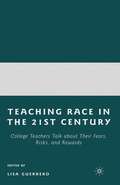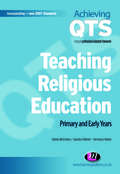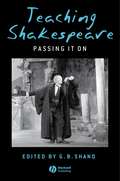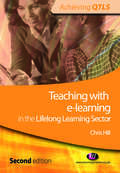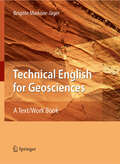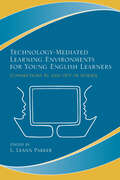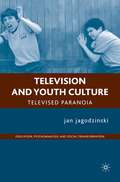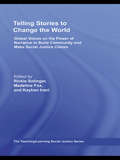- Table View
- List View
Teaching Race in the 21st Century: College Teachers Talk about Their Fears, Risks, and Rewards
by L. GuerreroThis collection brings together pedagogical memoirs on significant topics regarding teaching race in college, including student resistance, whiteness, professor identity, and curricula. Linking theory to practice, the essays create an accessible and useful way to look at teaching race for wide audiences interested in issues within education.
Teaching Religious Education
by Elaine Mccreery Sandra Palmer Veronica VoielsMany trainee primary teachers are uncertain as to the place and purpose of RE in primary schools. This book is designed to alleviate such fears and give trainees the security and confidence to teach RE effectively. Trainees are encouraged to recognise their own religious position and understand how they handle their own beliefs and commitments in the classroom. In addition, they will learn how to be sensitive to children's religious viewpoints, allowing children to share their beliefs in a secure and supportive environment. A range of strategies help readers to provide engaging and appropriate RE across the primary age phase.
Teaching Religious Education: Primary and Early Years
by Elaine Mccreery Sandra Palmer Veronica M VoielsMany trainee primary teachers are uncertain as to the place and purpose of RE in primary schools. This book is designed to alleviate such fears and give trainees the security and confidence to teach RE effectively. Trainees are encouraged to recognise their own religious position and understand how they handle their own beliefs and commitments in the classroom. In addition, they will learn how to be sensitive to children's religious viewpoints, allowing children to share their beliefs in a secure and supportive environment. A range of strategies help readers to provide engaging and appropriate RE across the primary age phase.
Teaching Science in the Primary Classroom
by Hellen Ward Judith Roden Julie Foreman Miss Claire HewlettThis exciting new edition of a popular book offers the reader the following new elements: - explicit advice on how to link science to cross-curricular learning - updated advice on planning and assessment - guidance on how to accommodate personalised learning within science - more on games to use in science - more on creativity - more on questioning techniques, an important aspect of scientific enquiry - a whole new chapter on using ICT to teach science. There are lots of practical examples, and clear guidance on how to turn theory into creative and lively science lessons and activities. Examples of children's work are included, and there are plenty of helpful case studies. Hellen Ward is Senior Lecturer at Canterbury Christ Church University, a widely-published author and a frequent presenter at conferences. Judith Roden is Principal Lecturer at Canterbury Christ Church University, and a successful author. Claire Hewlett and Julie Foreman are both Senior Lecturers at Canterbury Christ Church University.
Teaching Science in the Primary Classroom
by Hellen Ward Judith Roden Julie Foreman Claire HewlettThis exciting new edition of a popular book offers the reader the following new elements: - explicit advice on how to link science to cross-curricular learning - updated advice on planning and assessment - guidance on how to accommodate personalised learning within science - more on games to use in science - more on creativity - more on questioning techniques, an important aspect of scientific enquiry - a whole new chapter on using ICT to teach science. There are lots of practical examples, and clear guidance on how to turn theory into creative and lively science lessons and activities. Examples of children's work are included, and there are plenty of helpful case studies. Hellen Ward is Senior Lecturer at Canterbury Christ Church University, a widely-published author and a frequent presenter at conferences. Judith Roden is Principal Lecturer at Canterbury Christ Church University, and a successful author. Claire Hewlett and Julie Foreman are both Senior Lecturers at Canterbury Christ Church University.
Teaching Shakespeare: Passing It On
by G. B. ShandThis contemplative anthology offers personal essays by noted scholars on a range of topics related to the teaching of Shakespeare. Ideal for the graduate student, it addresses many of the primary concerns and rewards of the discipline, drawing on the variety of special skills, interests, and experiences brought to the classroom by the volume's distinguished contributors. Offers insight into the classroom practices, special skills, interests, and experiences of some of the most distinguished Shakespearean scholars in the field Features essayists who reflect on the experience of teaching Shakespeare at university level; how they approach the subject and why they think it is important to teach Provides anecdotal and practical advice for any reader interested in teaching the works of Shakespeare Engagingly candid
Teaching Unprepared Students: Strategies for Promoting Success and Retention in Higher Education
by Kathleen F. GabrielAs societal expectations about attending college have grown, professors report increasing numbers of students who are unprepared for the rigors of postsecondary education—not just more students with learning disabilities (whose numbers have more than tripled), but students (with and without special admission status) who are academically at-risk because of inadequate reading, writing and study skills. This book provides professors and their graduate teaching assistants—those at the front line of interactions with students—with techniques and approaches they can use in class to help at-risk students raise their skills so that they can successfully complete their studies.The author shares proven practices that will not only engage all students in a class, but also create the conditions—while maintaining high standards and high expectations—to enable at-risk and under-prepared students to develop academically and graduate with good grades. The author also explains how to work effectively with academic support units on campus. Within the framework of identifying those students who need help, establishing a rapport with them, adopting inclusive teaching strategies, and offering appropriate guidance, the book presents the theory teachers will need, and effective classroom strategies. The author covers teaching philosophy and goals; issues of discipline and behavior; motivation and making expectations explicit; classroom climate and learning styles; developing time management and study skills; as well as the application of “universal design” strategies.The ideas presented here—that the author has successfully employed over many years—can be easily integrated into any class.
Teaching Unprepared Students: Strategies for Promoting Success and Retention in Higher Education
by Kathleen F. GabrielAs societal expectations about attending college have grown, professors report increasing numbers of students who are unprepared for the rigors of postsecondary education—not just more students with learning disabilities (whose numbers have more than tripled), but students (with and without special admission status) who are academically at-risk because of inadequate reading, writing and study skills. This book provides professors and their graduate teaching assistants—those at the front line of interactions with students—with techniques and approaches they can use in class to help at-risk students raise their skills so that they can successfully complete their studies.The author shares proven practices that will not only engage all students in a class, but also create the conditions—while maintaining high standards and high expectations—to enable at-risk and under-prepared students to develop academically and graduate with good grades. The author also explains how to work effectively with academic support units on campus. Within the framework of identifying those students who need help, establishing a rapport with them, adopting inclusive teaching strategies, and offering appropriate guidance, the book presents the theory teachers will need, and effective classroom strategies. The author covers teaching philosophy and goals; issues of discipline and behavior; motivation and making expectations explicit; classroom climate and learning styles; developing time management and study skills; as well as the application of “universal design” strategies.The ideas presented here—that the author has successfully employed over many years—can be easily integrated into any class.
Teaching What They Learn, Learning What They Live: How Teachers' Personal Histories Shape Their Professional Development
by Brad Olsen"Cogent, interesting, and provocative."-from the foreword by Ann Lieberman Teaching What They Learn, Learning What They Live explores the multiple social, political, and epistemological domains that comprise learning-to-teach. Based on a study of eight beginning English teachers at four different university teacher preparation programs, this book examines the ways in which beginning teachers' personal dispositions and conceptions combines with their teacher preparation programs' professional knowledge and contexts to form their understandings of and approaches toward teaching. Brad Olsen recasts learning-to-teach as a continuous, situated identity process in which prior experiences produce deeply embedded ways of viewing the world that go on to organize current/future experience into meaning. Since experience shapes learning and everyone acquires different sets of experience, no individual teacher's knowledge is exactly like another's. Yet Olsen shows also that the process by which a teacher constructs professional knowledge is common: the what of teacher knowledge varies, but the how remains the same.
Teaching What They Learn, Learning What They Live: How Teachers' Personal Histories Shape Their Professional Development
by Brad Olsen"Cogent, interesting, and provocative."-from the foreword by Ann Lieberman Teaching What They Learn, Learning What They Live explores the multiple social, political, and epistemological domains that comprise learning-to-teach. Based on a study of eight beginning English teachers at four different university teacher preparation programs, this book examines the ways in which beginning teachers' personal dispositions and conceptions combines with their teacher preparation programs' professional knowledge and contexts to form their understandings of and approaches toward teaching. Brad Olsen recasts learning-to-teach as a continuous, situated identity process in which prior experiences produce deeply embedded ways of viewing the world that go on to organize current/future experience into meaning. Since experience shapes learning and everyone acquires different sets of experience, no individual teacher's knowledge is exactly like another's. Yet Olsen shows also that the process by which a teacher constructs professional knowledge is common: the what of teacher knowledge varies, but the how remains the same.
Teaching with e-learning in the Lifelong Learning Sector
by Chris HillThis new edition (previously entitled "Teaching Using Information and Learning Technology in Further Education") is an up to date resource for trainee and qualified teachers within the Lifelong Learning Sector. Focusing on information and learning technology as a toolkit for resourceful teachers, it includes reflective activities, teaching strategies and teaching tips throughout, along with ideas for applying these to the reader's own context. In this new edition, all material has been fully updated to reflect the latest changes in technology and its applications, and each chapter in the book is referenced to the new LLUK Standards.
Teaching with e-learning in the Lifelong Learning Sector (PDF)
by Chris HillThis new edition (previously entitled "Teaching Using Information and Learning Technology in Further Education") is an up to date resource for trainee and qualified teachers within the Lifelong Learning Sector. Focusing on information and learning technology as a toolkit for resourceful teachers, it includes reflective activities, teaching strategies and teaching tips throughout, along with ideas for applying these to the reader's own context. In this new edition, all material has been fully updated to reflect the latest changes in technology and its applications, and each chapter in the book is referenced to the new LLUK Standards.
Teaching with Intention: Defining Beliefs, Aligning Practice, Taking Action, K-5
by Debbie MillerEffective, intentional teaching begins with a strong set of beliefs, but even the best teachers -- including author Debbie Miller -- struggle to make sure that their classroom practice consistently reflects their core convictions. In Teaching with Intention: Defining Beliefs, Aligning Practice, Taking Action, K-5, Miller defines her actions to ensure that children are the true beneficiaries of her teaching. As Peter Johnston writes, Through this book we have Debbie's teaching mind on loan. She engages us in the details of a teaching life from inside her mind, showing the thinking behind her teaching and the consequences of her actions.Teaching with Intention brings us into classrooms of teachers and children Miller has met over the last five years in her work as a literacy consultant. From setting up the classroom environment to the intentional use of language, from comprehension instruction to lesson design, Miller is explicit about what she does and why. At the same time, she encourages teachers to develop their own belief statements concerning teaching and learning and includes key questions to guide them in this important process.In an environment where the handing down of scripted programs and foolproof curricula is increasingly the norm, Teaching with Intention offers a compelling reminder that truly transformative teaching is built from the ground up, and is rebuilt every year, by every teacher, in every classroom, with every new group of students.
Teaching with Intention: Defining Beliefs, Aligning Practice, Taking Action, K-5
by Debbie MillerEffective, intentional teaching begins with a strong set of beliefs, but even the best teachers -- including author Debbie Miller -- struggle to make sure that their classroom practice consistently reflects their core convictions. In Teaching with Intention: Defining Beliefs, Aligning Practice, Taking Action, K-5, Miller defines her actions to ensure that children are the true beneficiaries of her teaching. As Peter Johnston writes, Through this book we have Debbie's teaching mind on loan. She engages us in the details of a teaching life from inside her mind, showing the thinking behind her teaching and the consequences of her actions.Teaching with Intention brings us into classrooms of teachers and children Miller has met over the last five years in her work as a literacy consultant. From setting up the classroom environment to the intentional use of language, from comprehension instruction to lesson design, Miller is explicit about what she does and why. At the same time, she encourages teachers to develop their own belief statements concerning teaching and learning and includes key questions to guide them in this important process.In an environment where the handing down of scripted programs and foolproof curricula is increasingly the norm, Teaching with Intention offers a compelling reminder that truly transformative teaching is built from the ground up, and is rebuilt every year, by every teacher, in every classroom, with every new group of students.
Teaching Your First College Class: A Practical Guide for New Faculty and Graduate Student Instructors
by Carolyn LiebergNo other teaching experience will feel quite like the first time an instructor walks into a classroom to face a class of students.This book is a wise and friendly guide for new faculty and graduate student instructors who are about to teach for the first time. It provides an introduction to the theory of teaching; describes proven strategies and activities for engaging students in their learning; and offers advice on classroom management, syllabus creation, grading, assessment, and discipline issues, among other topics. It prepares readers for a confident start as teachers, and gives them a firm foundation on which to develop their skills and personal classroom styles.The author breaks teaching down into its component elements and tasks to enable graduate student instructors to identify their particular responsibilities, and learn about what works and does not. They will also benefit from reading the book as a whole as it sets their work in the context of course objectives and learning theory.For new faculty this engaging book provides a solid basis from which to develop their skills and personal styles as teachers; and offers guidance on documenting their classroom success for the purposes of promotion and tenure. For graduate student instructors, the book is a companion that will give them confidence and pleasure in teaching, and stand them in good stead if they decide on a in any future career in academe.
Teaching Your First College Class: A Practical Guide for New Faculty and Graduate Student Instructors
by Carolyn LiebergNo other teaching experience will feel quite like the first time an instructor walks into a classroom to face a class of students.This book is a wise and friendly guide for new faculty and graduate student instructors who are about to teach for the first time. It provides an introduction to the theory of teaching; describes proven strategies and activities for engaging students in their learning; and offers advice on classroom management, syllabus creation, grading, assessment, and discipline issues, among other topics. It prepares readers for a confident start as teachers, and gives them a firm foundation on which to develop their skills and personal classroom styles.The author breaks teaching down into its component elements and tasks to enable graduate student instructors to identify their particular responsibilities, and learn about what works and does not. They will also benefit from reading the book as a whole as it sets their work in the context of course objectives and learning theory.For new faculty this engaging book provides a solid basis from which to develop their skills and personal styles as teachers; and offers guidance on documenting their classroom success for the purposes of promotion and tenure. For graduate student instructors, the book is a companion that will give them confidence and pleasure in teaching, and stand them in good stead if they decide on a in any future career in academe.
TeamWork: Setting the Standard for Collaborative Teaching, Grades 5-9
by Monique Wild Amanda Mayeaux Kathryn EdmondsTeamWork: Setting the Standard for Collaborative Teaching, Grades 5–9is full of captivating stories and insightful conversations. The teamers provide an honest and richly detailed explanation of collaborative teaching in action. They deliver the straight scoop on teaming, offering insights on these and other key topics: How to shape a shared purpose for learning by mining the talents of students and colleagues How to build strong partnerships with parents, principals, and other key people who influence the lives of young adolescents How to deepen curriculum integration by cutting the fluff.This insider' s guide to teaming reveals the conversations, the conflicts, and the collegial sharing that enables teachers to collaborate so that every member of the team can meet the highest standards of professional practice. For new teachers and seasoned veterans alike, TeamWork provides a powerful foundation for achievement.
TeamWork: Setting the Standard for Collaborative Teaching, Grades 5-9
by Monique Wild Amanda Mayeaux Kathryn EdmondsTeamWork: Setting the Standard for Collaborative Teaching, Grades 5–9is full of captivating stories and insightful conversations. The teamers provide an honest and richly detailed explanation of collaborative teaching in action. They deliver the straight scoop on teaming, offering insights on these and other key topics: How to shape a shared purpose for learning by mining the talents of students and colleagues How to build strong partnerships with parents, principals, and other key people who influence the lives of young adolescents How to deepen curriculum integration by cutting the fluff.This insider' s guide to teaming reveals the conversations, the conflicts, and the collegial sharing that enables teachers to collaborate so that every member of the team can meet the highest standards of professional practice. For new teachers and seasoned veterans alike, TeamWork provides a powerful foundation for achievement.
The Technique of Pencil Drawing
by Borough JohnsonOnly a thoroughly accomplished artist such as Borough Johnson--a nineteenth-century landscape and genre painter--could manage to illuminate the technique of pencil drawing in these exquisitely simple terms. Artists at every level of experience will appreciate the wealth of information he offers on everything from choosing the right tools to drawing the nude figure. With a host of helpful "how-to" illustrations, as well as a "mini-gallery" of finished compositions, this invaluable guide offers clear direction for artists who want to learn to draw--or sharpen their skills. Johnson starts with the basics, explaining how to hold a pencil for the greatest control, how to select the right paper, and how to add shading and tone for the best results. "The range of effects is infinite," he affirms. Moving outdoors, he tackles landscapes, seascapes, and other scenery, demonstrating where to start your sketch and where to leave off. When drawing the nude figure, he suggests quick poses to capture body structure and balance before adding detail. Best of all, Johnson explores the importance of individuality in each artist and how each one's expression should be absolutely unique. When you see the magnificent artwork included--from stunning portraits of dancers and fishermen to splendid scenes in Venice and Pisa--you'll be inspired to master this expressive art form.
Technology-Mediated Learning Environments for Young English Learners: Connections In and Out of School
This book explores issues related to the use of technologies to support young second-language learners and looks at promising areas for research, design, and development. Grounded in a sociocultural theoretical framework, it invites educators, researchers, and educational technology developers to consider a range of social and cultural factors in utilizing technology as a tool to help children from diverse linguistic and cultural backgrounds develop their English-language and reading skills. A major contribution is the authors’ consideration of ways that technology outside of school can benefit these students’ English-language development in school. The central chapters are counter pointed by invited reflections that bring to the discussion different, yet complementary, perspectives from notable scholars in the field of second-language literacy and learning.Technology-Mediated Learning Environments for Young English-Language Learners is targeted to researchers, educators, and policymakers in the areas of elementary education, after-school learning, second-language teaching and learning, English language and literacy development, and reading.
Technology-Mediated Learning Environments for Young English Learners: Connections In and Out of School
by L. Leann ParkerThis book explores issues related to the use of technologies to support young second-language learners and looks at promising areas for research, design, and development. Grounded in a sociocultural theoretical framework, it invites educators, researchers, and educational technology developers to consider a range of social and cultural factors in utilizing technology as a tool to help children from diverse linguistic and cultural backgrounds develop their English-language and reading skills. A major contribution is the authors’ consideration of ways that technology outside of school can benefit these students’ English-language development in school. The central chapters are counter pointed by invited reflections that bring to the discussion different, yet complementary, perspectives from notable scholars in the field of second-language literacy and learning.Technology-Mediated Learning Environments for Young English-Language Learners is targeted to researchers, educators, and policymakers in the areas of elementary education, after-school learning, second-language teaching and learning, English language and literacy development, and reading.
Teilhaben an Schule: Zu den Chancen wirksamer Einflussnahme auf Schulentwicklung
by Thomas RihmDer Band präsentiert ein alternatives Konzept zur Schulentwicklung, bei dem die SchülerInnen und ihre Teilhabechancen im Zentrum der Diskussion stehen. Teilhabe meint hier die wirksame, selbstbestimmte Einflussnahme, nicht der üblicherweise praktizierte stellvertretende Einbezug der Lernenden durch die Lehrenden und die Schulleitung. Entsprechend geht es darum, die notwendigen Handlungsräume auszuloten, die die Lernenden haben müssen, damit sie sich maßgeblich an der Entwicklung ihrer Schule beteiligen können.
Television and Youth Culture: Televised Paranoia (Education, Psychoanalysis, and Social Transformation)
by J. jagodzinskiThis book explores youth in postmodern society through a Lacanian lens. Jagodzinski explores the generalized paranoia that pervades the landscape of television. Instead of dismissing paranoia as a negative development, he claims that youth today labour within the context of paranoia to find their identities.
Telling Stories to Change the World: Global Voices on the Power of Narrative to Build Community and Make Social Justice Claims (Teaching/Learning Social Justice)
by Rickie Solinger Madeline Fox Kayhan IraniTelling Stories to Change the World is a powerful collection of essays about community-based and interest-based projects where storytelling is used as a strategy for speaking out for justice. Contributors from locations across the globe—including Uganda, Darfur, China, Afghanistan, South Africa, New Orleans, and Chicago—describe grassroots projects in which communities use narrative as a way of exploring what a more just society might look like and what civic engagement means. These compelling accounts of resistance, hope, and vision showcase the power of the storytelling form to generate critique and collective action. Together, these projects demonstrate the contemporary power of stories to stimulate engagement, active citizenship, the pride of identity, and the humility of human connectedness.
